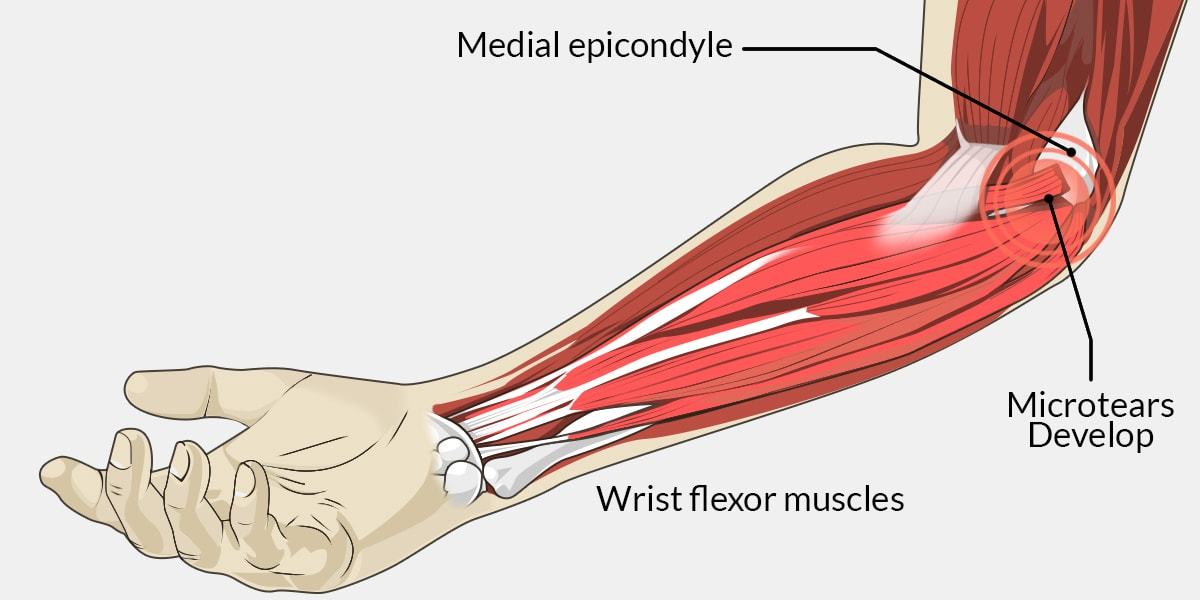|
BOOK NOW |
ASK ABOUT YOUR PAIN |
Home > Blog > Physiotherapy & Hand Therapy > Golfer's Elbow (Medial Epicondylitis) Physiotherapy
Golfer's Elbow (Medial Epicondylitis) Physiotherapy

Medial epicondylitis (commonly called golfer's elbow or thrower's elbow) is a condition that develops when the tendons on the inside of the forearm, closer to the inside part of the elbow where the flexor origins of the forearm flexor muscles become irritated, inflamed, and painful due to repetitive use of the hand, wrist, forearm and elbow.
It is often diagnosed in patients who perform repetitive motions, such as swinging a golf club or tennis racket, or activities requiring gripping, twisting, or throwing. Even using a computer work, garden/yard work or housework like cleaning and cooking can cause it too.
It is common in men and women over the age of 35.
Our senior hand therapists and senior physiotherapists can help
- decrease the pain caused by medial epicondylitis and
- improve the affected elbow's motion, strength, and function
What is Medial Epicondylitis (Golfer's Elbow)?
Medial epicondylitis is a painful elbow/forearm flexor condition that occurs when the tendons on the inside of the forearm become irritated, inflamed, and painful due to repetitive use of the hand, wrist, and forearm.
A tendon is a soft tissue that attaches a muscle to a bone.
The group of muscles that is primarily affected by medial epicondylitis are the muscles and tendons which function is to flex (bend) the wrist, fingers, and thumb and pronate (rotate palm-down) the wrist and forearm.
This specific muscle group is located together in a common sheath and attaches to the humerus bone of the upper arm. This bony prominence, called the medial epicondyle, is located along the inside of the elbow.
So when these structures are over-used, pain occurs on or near the medial epicondyle, at the area where the tendon connects to the bone. Repetitive forces will cause the tendon to become inflamed, tender and irritated, and without treatment, can unfortunately even cause it to even tear and rupture away from the bone.
To add to that, as these specific tendons and muscles cross both the elbow and the wrist (2 joints), they function to stabilize at the
elbow allowing for wrist movement. As this is a 2-joint tendon, it is
more vulnerable to injury (due to being longer and crossing more joints)
How Does it Feel?
Persons with medial epicondylitis may experience:
- Pain along the inside of the forearm with wrist, hand, or elbow movements.
- Pain or numbness and tingling that radiates from the inside of the elbow down into the hand and fingers, with gripping or squeezing movements.
- Tenderness to touch and swelling along the inside of the forearm.
- Weakness in the hand and forearm when attempting to grip objects.
- Elbow stiffness (form of joint stiffness).
How Is Golfer's Elbow (Medial Epicondylitis) Diagnosed?
Our senior hand therapists or senior physiotherapists will perform an evaluation and ask you questions about pain or other symptoms you are feeling.
We may
- perform strength and motion tests on your wrist, forearm, and elbow
- ask about your job duties and hobbies
- evaluate your posture
- check for any muscle imbalances and weakness that can occur anywhere along the path from your shoulder blade to your hand
We will gently touch your elbow in specific areas to determine which tendon or tendons may be inflamed. Special muscle tests, such as bending the wrist or rotating the forearm with resistance, also may be performed to ensure a proper diagnosis.
how our senior hand therapists and senior physiotherapists can help

Please consider that it is important to get proper treatment for medial epicondylitis as soon as it happens, because tendon injuries tend to recur and are slow to heal because tendons do not have a good blood supply.
An inflamed tendon that is not treated can begin to tear, causing a more serious condition.
When a diagnosis of medial epicondylitis is made, you can immediately work with our senior hand therapists and senior physiotherapist to devise a treatment plan that is specific to your condition and goals.
Your hand therapy and physiotherapy treatment program may include:
Pain Management
We will help you identify and avoid painful movements to allow the inflamed tendon to heal. Cold therapy or heat therapy may be used for pain management.
Therapeutic modalities, such as iontophoresis (medication delivered through an electrically charged patch), and ultrasound therapy to accelerate soft tissue healing may be applied. Bracing or splinting may also be prescribed.
In severe cases, it may be necessary to rest the elbow and not perform work or sport activities that continue causing pain, which may slow the recovery process.
Manual Therapy
We may use manual techniques, such as gentle joint movements, soft-tissue massage, and elbow, forearm, and wrist stretches to help the muscles regain full movement. We may also do manual stretching and manual techniques to your shoulder and thoracic spine, as your tendons along the medial elbow can be affected by muscle imbalances all the way up the chain.
Range-of-Motion Exercises
You will learn mobility exercises and self-stretches to help your elbow and wrist maintain proper movement.
Strengthening Exercises
We will determine which strengthening exercises are right for you, depending on your specific condition, as your pain subsides. You may use weights, medicine balls, resistance bands, and other types of resistance training to challenge your weaker muscles.